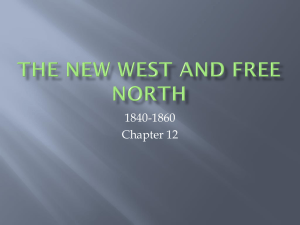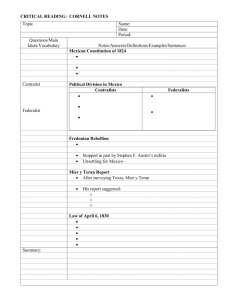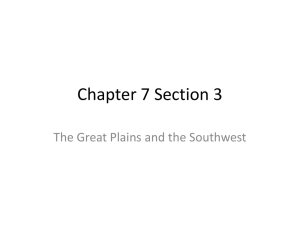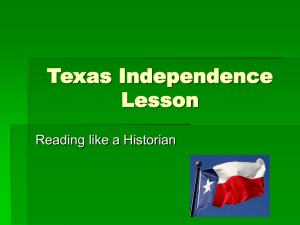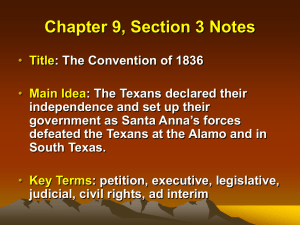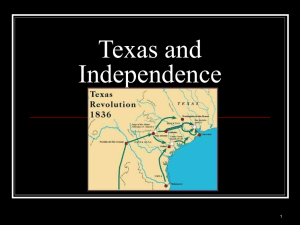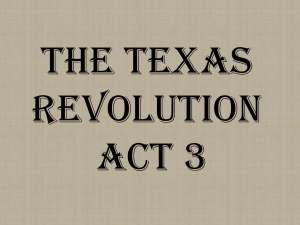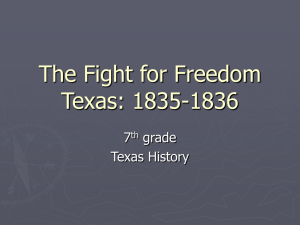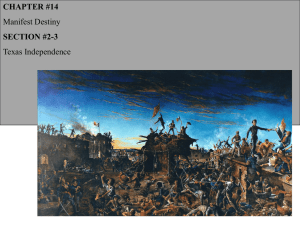Texas Revolution Notes
advertisement
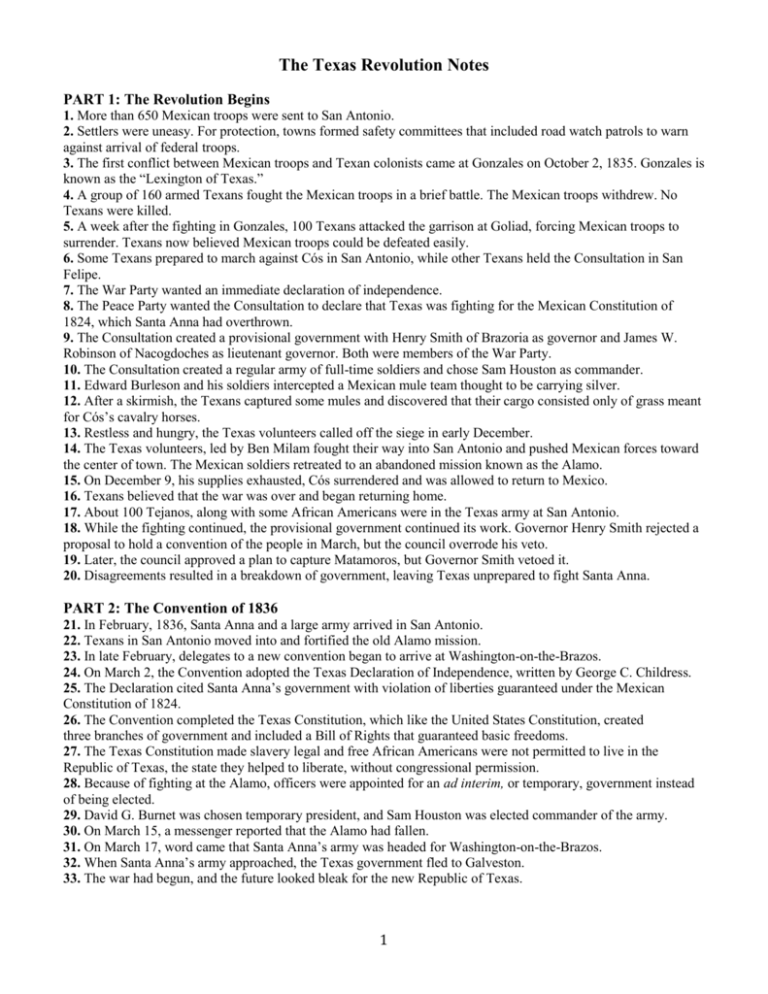
The Texas Revolution Notes PART 1: The Revolution Begins 1. More than 650 Mexican troops were sent to San Antonio. 2. Settlers were uneasy. For protection, towns formed safety committees that included road watch patrols to warn against arrival of federal troops. 3. The first conflict between Mexican troops and Texan colonists came at Gonzales on October 2, 1835. Gonzales is known as the “Lexington of Texas.” 4. A group of 160 armed Texans fought the Mexican troops in a brief battle. The Mexican troops withdrew. No Texans were killed. 5. A week after the fighting in Gonzales, 100 Texans attacked the garrison at Goliad, forcing Mexican troops to surrender. Texans now believed Mexican troops could be defeated easily. 6. Some Texans prepared to march against Cós in San Antonio, while other Texans held the Consultation in San Felipe. 7. The War Party wanted an immediate declaration of independence. 8. The Peace Party wanted the Consultation to declare that Texas was fighting for the Mexican Constitution of 1824, which Santa Anna had overthrown. 9. The Consultation created a provisional government with Henry Smith of Brazoria as governor and James W. Robinson of Nacogdoches as lieutenant governor. Both were members of the War Party. 10. The Consultation created a regular army of full-time soldiers and chose Sam Houston as commander. 11. Edward Burleson and his soldiers intercepted a Mexican mule team thought to be carrying silver. 12. After a skirmish, the Texans captured some mules and discovered that their cargo consisted only of grass meant for Cós’s cavalry horses. 13. Restless and hungry, the Texas volunteers called off the siege in early December. 14. The Texas volunteers, led by Ben Milam fought their way into San Antonio and pushed Mexican forces toward the center of town. The Mexican soldiers retreated to an abandoned mission known as the Alamo. 15. On December 9, his supplies exhausted, Cós surrendered and was allowed to return to Mexico. 16. Texans believed that the war was over and began returning home. 17. About 100 Tejanos, along with some African Americans were in the Texas army at San Antonio. 18. While the fighting continued, the provisional government continued its work. Governor Henry Smith rejected a proposal to hold a convention of the people in March, but the council overrode his veto. 19. Later, the council approved a plan to capture Matamoros, but Governor Smith vetoed it. 20. Disagreements resulted in a breakdown of government, leaving Texas unprepared to fight Santa Anna. PART 2: The Convention of 1836 21. In February, 1836, Santa Anna and a large army arrived in San Antonio. 22. Texans in San Antonio moved into and fortified the old Alamo mission. 23. In late February, delegates to a new convention began to arrive at Washington-on-the-Brazos. 24. On March 2, the Convention adopted the Texas Declaration of Independence, written by George C. Childress. 25. The Declaration cited Santa Anna’s government with violation of liberties guaranteed under the Mexican Constitution of 1824. 26. The Convention completed the Texas Constitution, which like the United States Constitution, created three branches of government and included a Bill of Rights that guaranteed basic freedoms. 27. The Texas Constitution made slavery legal and free African Americans were not permitted to live in the Republic of Texas, the state they helped to liberate, without congressional permission. 28. Because of fighting at the Alamo, officers were appointed for an ad interim, or temporary, government instead of being elected. 29. David G. Burnet was chosen temporary president, and Sam Houston was elected commander of the army. 30. On March 15, a messenger reported that the Alamo had fallen. 31. On March 17, word came that Santa Anna’s army was headed for Washington-on-the-Brazos. 32. When Santa Anna’s army approached, the Texas government fled to Galveston. 33. The war had begun, and the future looked bleak for the new Republic of Texas. 1 PART 3: The Alamo 34. Santa Anna was determined to rid Mexico of the Anglo rebels and punish the defiant Tejanos. 35. The Texans did not use wisely the time they had before Santa Anna arrived. Instead of organizing and training, most of the volunteer soldiers who had captured San Antonio went home. In 1835 the divided and disorganized Texas forces had no leader and refused to recognize General Houston as their commander. 36. Texas forces were scattered, with little communication and coordination. 37. Santa Anna moved his army of 6,000 troops northward from Mexico City. 38. Part of the army was recruited quickly, and most of the new troops were untrained and undisciplined. 39. Santa Anna learned of Texas troop movement from some Mexican ranchers along his route. 40. The Alamo in San Antonio was occupied by 104 Texan soldiers under the command of Colonel Neill. 41. Houston ordered Colonel James Bowie and about 25 Texans in Goliad to assess and inspect the situation at the Alamo. 42. Colonel Travis and 30 soldiers from San Felipe joined the Alamo garrison, as did David Crockett and his band of volunteers. 43. Bowie was chosen commander of the volunteers and Travis the commander of the regular army after Colonel Neill’s departure due to a family illness. Both served as joint commanders of the garrison until Bowie became ill. Then Travis took command and waited for Santa Anna to enter Texas. 44. Bowie and Travis believed that they did not have enough soldiers to properly defend the Alamo, but that holding the Alamo at any cost was vital to the future of Texas. The mission walls were incomplete, hampering the defense. 45. Determined to hold the Alamo, Travis wrote several messages to the people of Texas and to the United States asking for assistance. He received little response to his pleas for aid because the Texas forces were poorly organized. 46. Fannin and his army at Goliad lacked enough wagons to move his supplies to aid the Alamo defenders. 47. On March 1, only 32 reinforcements arrived at the Alamo from Gonzales. 48. At his headquarters in San Fernando Church, Santa Anna flew the red “no quarters” flag, meaning that he would take no prisoners. 49. On March 3, Travis explained to his troops that remaining at the Alamo meant certain death. According to legend, he drew a line on the ground with his sword and invited those who wished to stay to cross the line. 50. Almost 200 men, mostly volunteers, were free to leave but decided to stay and fight for their beliefs. 51. The final assault began on the morning of March 6, 1836 at 5:30 A.M. An estimated 1,800 Mexican troops took part, attacking at three different points. The garrison was overpowered by 7:00 A.M. on March 6, and the battle for the Alamo ended. 52. The battle of the Alamo delayed Santa Anna for two weeks, to the advantage of Texans. 53. Some people believe that Texas would not have won independence without the battle of the Alamo. 54. The battle and the courage of the Texans at the Alamo made Texans more determined to win independence. 55. Instead of discouraging the people of Texas, the loss of the Alamo inspired other Texans to carry on the struggle. 56. Sam Houston’s army adopted the battle cry “Remember the Alamo!” PART 4: Goliad Massacre 57. While the Alamo battle raged, the second unit of the Mexican army, under General José Urrea, advanced through South Texas. 58. As he advanced, Urrea defeated and killed Texan soldiers in San Patricio, Refugio, and Victoria. 59. Fannin delayed several days before retreating from Goliad toward Victoria at Houston’s command. The delay hurt the Texan cause. 60. On March 19, while Fannin and his men rested in a field near Coleto Creek, Urrea’s troops surrounded them. 61. Fannin assembled his 300 troops in a square and three times drove back the Mexican army of 450 to 600 men. 62. Urrea assured the Texans that they would be treated fairly, although the surrender agreement made no such promises. 63. Texans were marched back to Goliad and imprisoned in the old presidio. Urrea wrote to Santa Anna, asking that he be allowed to spare the prisoners’ lives. Santa Anna ordered their immediate execution, fearing that if he let the Texans go they would join others in rebellion. On Palm Sunday, March 27, the prisoners were taken out to a field and shot. 64. Santa Anna thought Texans would give up after the fall of the Alamo. It had the opposite effect. 2 65. The fighting in South Texas did show the lack of teamwork among the Texas forces. 66. The defeats convinced Houston not to let his forces separate into small groups. PART 5: Two Armies in Texas 67. The fall of the Alamo and the losses in South Texas opened the way for Santa Anna to move farther into South Texas. 68. Santa Anna prepared to return to Mexico and leave General Vincente Filisola to finish the task of defeating the rebels. 69. But Filisola knew the task would not be easy. He believed the Texans would fight to protect their homes, and he persuaded Santa Anna to delay his departure. 70. Houston arrived at Gonzales on March 11 and found 370 volunteers who answered Travis’s pleas from the Alamo. 71. With 400 troops he retreated eastward toward the Colorado River, hoping to pick up additional men. 72. He needed Fannin’s 300 men and ordered Fannin to retreat from Goliad and join him. 73. Houston’s army began its withdrawal from Gonzales on March 13 and grew to nearly 1,000 volunteers. 74. Houston learned that Fannin and his soldiers had been captured. 75. Houston’s soldiers became resentful because their homes were being destroyed, and they wanted to fight the Mexican soldiers. Houston, however, believed that his forces were still too weak. 76. Hundreds of families, fearing that the Mexican army would move in and harm them, moved east. 77. Heavy spring rains and sickness made the journey miserable. This movement became known as the Runaway Scrape. 78. On March 28, Houston’s army reached the Brazos River, but two companies refused to retreat farther. 79. Leaving those two companies to guard the river crossing, Houston and the main body of his army moved northward along the Brazos River. 80. Houston drilled his men for nearly two weeks. 81. On April 5, Santa Anna crossed the Colorado River and tried to overtake the Texans. 82. Houston moved southeast toward the San Jacinto River. He received two cannons, the “Twin Sisters,” as a gift from the people of Cincinnati, Ohio. Houston then moved south to Harrisburg, prepared to fight. PART 6: The Battle of San Jacinto 83. On April 20, 1836, Texan troops camped on the banks of Buffalo Bayou. 84. Santa Anna’s army moved to the edge of a prairie opposite the Texans. 85. Santa Anna was in a poor position but believed the Texans would not attack. 86. Juan Seguín, a Tejano supporting independence, commanded 20–30 Tejanos. The Tejanos wore a piece of cardboard in their hats to distinguish them from Mexican troops. 87. Santa Anna had 850 troops; 540 more joined them. 88. Houston ordered the bridge across Vince’s Bayou destroyed to cut off a retreat for both armies. 89. Houston called his officers to a council of war, but they disagreed over whether to attack directly or set up a defensive position. 90. On the afternoon of April 21, Houston ordered the Texas army to advance on the Mexican troops who were resting. 91. The Texans seized the Mexican artillery. The Mexican camp was in total confusion as soldiers tried to fight and flee. 92. The battle lasted only 18 minutes. The Texans were victorious. 93. The Mexican army suffered heavy losses at San Jacinto. An estimated 630 Mexicans were killed and 730 were taken prisoner, including Santa Anna. Santa Anna surrendered. 94. After the battle, Houston’s report to President Burnet praised his troops highly for their courage and loyalty. 95. Santa Anna’s report to his superiors explained that the loss was due to the high number of inexperienced recruits. 96. After the battle, Santa Anna signed two peace treaties, known as the Treaties of Velasco. 97. In the public treaty, Santa Anna agreed to never fight against the Texans and to remove all troops from Texas and exchange prisoners. 98. In the secret treaty, Santa Anna agreed to work for Mexican recognition of Texas independence and to set the boundary at the Rio Grande. Discussion Question 3
